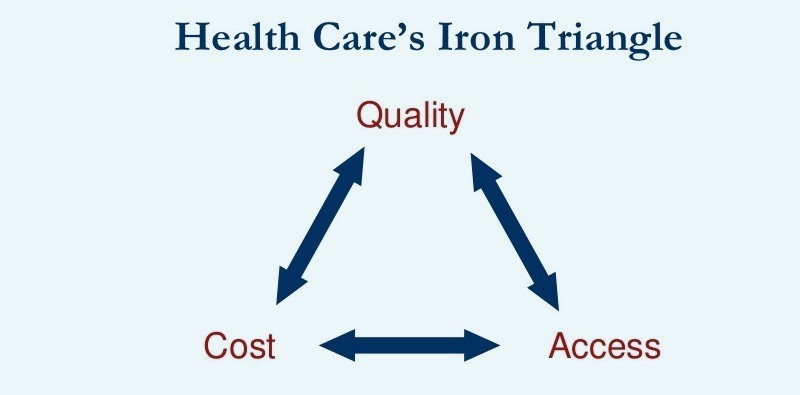The Iron Triangle: the Challenges of Creating Value in Healthcare

Categories: Healthcare Industry Trends
July 17, 2023
As a healthcare revenue cycle management company, RevUp Billing follows news stories that explore the complexity of healthcare spending and delivery. In many of these articles, a common theme is that healthcare providers need to create value for their patients.
However, as one examines the concept of value, it is helpful to look at the core concepts and desired outcomes in healthcare and how they sometimes compete with each other. The term "value" is not always easy to define and recognize.
The Iron Triangle of Healthcare
The idea of creating value in the healthcare industry usually centers around three concepts. These concepts are access, cost and quality; or what some have called the Iron Triangle of healthcare.
Historically, the term “the iron triangle” was first used to describe the connections that exist between the policy-making relationship among the congressional committees, the bureaucracy and interest groups. A concept from U.S. History and the Cold War. However, in the case of healthcare, the concept is applied to care delivery and cost.
The term “the Iron Triangle of Health Care" is largely credited to William Kissisk's book Medicine's Dilemmas: Infinite Needs Versus Finite Resources (1994). The book presents the concept of three competing attributes in the American healthcare system. The three essential questions that health systems need to address are:
- Access - How easily can patents gain access to healthcare services?
- Quality - What is the quality of healthcare that is delivered to patients?
- Cost Containment - How expensive is it to deliver healthcare services?
Visually, each of these "terms" or "concepts" reside at the corner of a theoretical “triangle” shape.
As one moves between these concepts, the consequences of each attribute change, with one concept increasing while the other concept decreases. For example, a policy that increases access to health services would likely lower the quality of healthcare or increase the overall cost of the delivery of treatments.
In this Iron Triangle paradigm, the ideal situation is one where healthcare professionals provide easy access to services that are of high quality, but delivered at the lowest possible cost. For example, insurance provider Cigna Healthcare advocates creating value by transitioning to a value-based healthcare system. This includes value-based reimbursement models and improved health, affordability and patient experience.
The closer healthcare providers are at moving to this ideal, the closer they are to delivering or producing “value” in this healthcare model. This has produced, or at least greatly influenced, the increasingly common term known as value-based care. This sounds straightforward, but as many economists would agree - there is usually an opportunity cost.
In the Iron Triangle of Health Care model, some industry observers would argue that it is impossible to simultaneously maximize all three of these concepts. The discussion is made even more complex due to the fact that features like "cost" can quickly change. In other cases, new technologies can disrupt well-established healthcare models.
People are looking for the best possible outcome in healthcare. As a reminder, there are many political and financial “interests” in the healthcare marketplace. Sometimes these interests work together and collaborate, but other times they directly compete with one another. This debate surrounding medical expenses, healthcare access and service quality will only intensify as more Americans age and become eligible for Medicare benefits and require health services.
About Us
RevUp Billing provides experienced and professional revenue cycle management services for healthcare professionals. Our other services include insurance credentialing as well as billing/software services for I-DD provider agencies.
If you have additional questions - contact us.
RevUp Billing provides trusted and experienced billing services for I-DD provider agencies and similar direct care organizations. Like, subscribe and follow RevUp Billing on Facebook, Instagram, LinkedIn & Twitter.
Updated from original article published on October 11, 2016
Categories
Have a question? Get in touch with us!
For an in-depth proposal on our services, complete our contact form to request a proposal. We'll get back to you asap.
Contact UsPopular Articles: DSPs
Popular Articles: I-DD Provider Agency
Popular Articles: eWebSchedule
Additional News
Search for information and news on provider agencies for individuals with development disabilities, billing trends as well as other related topics.